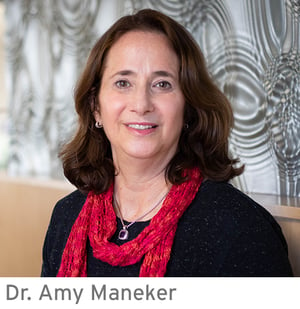User dissatisfaction with the EHR is one of the most common problems that organizations face across the care continuum today. While you may be aware that your end users are unhappy with your EHR, it’s difficult to know how exactly to address this problem. The good news is, there’s a lot we can learn from industry research on EHR adoption and usability.
According to a report from KLAS' Arch Collaborative, an EHR usability-focused initiative, ‘shared ownership’ is one important component of having successful and satisfied EHR users. Arch Collaborative members have found that organizations that have established a shared ownership program better engage end users in the EHR. These owners become the conduit for sharing information and obtaining input from their peers as well as owning aspects of the EHR configuration as well as the medical content.
So how do you establish shared ownership and increase EHR satisfaction at your organization? Dr. Amy Maneker, physician executive at Nordic, and Leanna Hester, RN, director of Optimization Solutions at Nordic, recommend three steps below to get started — shared ownership strategies they've helped other health IT leaders incorporate at their organizations.
1. Identify roles and responsibilities
 Every successful shared ownership program consists of key players. These key players, or owners, will help manage two-way communication, working as a liaison for their specialty or department. They are instrumental in garnering feedback from their colleagues to inform any changes to the EHR build, as well as proactively communicating EHR enhancements or updates to their colleagues. This helps increase awareness around how EHR enhancements will impact department-specific workflows.
Every successful shared ownership program consists of key players. These key players, or owners, will help manage two-way communication, working as a liaison for their specialty or department. They are instrumental in garnering feedback from their colleagues to inform any changes to the EHR build, as well as proactively communicating EHR enhancements or updates to their colleagues. This helps increase awareness around how EHR enhancements will impact department-specific workflows.
Each organization should feel free to explore, by trial and error if necessary, which roles and procedures will best meet their needs. One size does not fit all when it comes to assembling this team of owners.
For example, when it comes to physicians, some vendors and provider organizations prefer to select “physician builders” who focus on the EHR build and workflows. This role has indeed worked wonders for many health systems. However, some organizations find it too expensive or otherwise unrealistic to have a crew of physicians spending significant time on the build process.
Several organizations have instead adopted a role that we like to call the “physician architect.” This person may not be involved in the actual work of building the EHR but is instead responsible for helping design clinical decision support and other solutions that inform quality and process improvement endeavors.
One organization we’ve worked with had an Epic Medical Lead role. This was a 0.1 physician FTE who had robust knowledge of Epic functionality, owned the medical content for their specialty (i.e., preference lists and order sets), and could assist in the development of advanced training as well as tools to enhance provider efficiency and the quality of clinical care. These Epic Medical Leads also played a role in advanced provider training.
There are other roles that may be less labor and time intensive but still ensure clinician satisfaction for their specialty area. It’s important to note that the clinician roles do not necessarily need to be the same across the organization —there can be some mixing and matching in different areas or specialties.
2. Assemble your team of shared owners
 Once you’ve identified which roles will make up a shared owner program for your clinicians, you’ll need to select the right people to fill the roles. These individuals should show a vested interest in helping their fellow team members use the tools effectively to make the EHR the best it can be.
Once you’ve identified which roles will make up a shared owner program for your clinicians, you’ll need to select the right people to fill the roles. These individuals should show a vested interest in helping their fellow team members use the tools effectively to make the EHR the best it can be.
Often, organizations think they need to select the most senior physician on staff or a nurse with the most IT experience to serve as their owners. In some cases, this may be the right person for the job, but in other cases it may not be. You’ll want to do your due diligence before assembling this team to make sure you’re selecting individuals who are enthusiastic about the work they’ll be doing to improve the EHR. You should create a process for selecting individuals to fill the roles.
In our experience, volunteers are the way to go. If your owners are volunteering, they’ll most likely already be excited about the opportunity to improve the status quo and be a part of the solution. It’s very important that volunteers have the support and/or recommendation of their department leader. If the division head or department chair doesn’t support them in this role, success is much less likely.
These owners also will need to be given the time to do this work. Typically, this means that some percentage of their role is dedicated to informatics. In some organizations, they are compensated for the additional time spent on informatics.
These individuals don’t necessarily need to know the most about the EHR, but they should be willing to learn. Other qualities of an ideal clinician owner include good communication skills, patience with the process, strategic vision, and a can-do attitude. These qualities will make a big difference during an EHR enhancement process that can be somewhat complicated at times.
3. Enable, empower, and set expectations
Shared ownership is an effective way to manage change throughout your organization. However, for good or for bad, change doesn’t happen overnight. To help set expectations, make sure to clarify goals and timelines with your team of clinician owners, spelling out what they should plan to accomplish, how to accomplish it, and what success looks like.
Make timelines and deadlines clear for everyone. It’s important they know that they may not see results right away and that it may take some time to reach the goals and milestones you’ve laid out for them. And that’s OK! Try to keep the information-gathering process as agile as possible, so your owners feel empowered. They should feel that their input is valuable (because it is) and results in action. This is a foundational element of shared ownership and a healthy culture.
Last, to feel even more empowered, this team will need education. This can come by way of training, coaching, and mentoring, including some advanced education about the EHR. Owners will need to understand the difference between small issues that result in quick fixes and bigger problems that will take outside help. They also need to know the chain of command as well as your IT processes. As they say, knowledge is power.
Those in ownership roles need to feel needed and understand that if they don’t do their jobs, nobody will. In short, these clinicians must feel accountable for the success of the EHR.
If you have questions about establishing a shared ownership program at your organization, please reach out. We’d love to discuss your specific goals and challenges around increasing end user satisfaction with your EHR.
Dr. Maneker is an experienced physician executive and Chief Medical Information Officer with an expertise in leveraging information and technology to improve quality and value of healthcare. At Nordic, she uses this expertise to help our client partners enhance their EHR systems. She has more than 25 years of clinical experience, serving as a pediatrician and pediatric emergency medicine physician. For the last 15 years, her career has been focused in the Clinical Informatics arena, serving as Vice President and Chief Medical Information Officer at Akron Children’s Hospital where she supported the development, implementation and adoption of high quality and innovative clinical information systems (including Epic) to assist in delivery of patient care and maximize patient safety and quality of care.
Leanna Hester is a Director of Optimization Solutions at Nordic leading development and execution of Strategic Solutions. She works with clients to make their people, processes, and technology more efficient and supportive of the organizational goals. Leanna brings 14 years of healthcare experience and is passionate about drawing from her IT expertise and nursing background to help healthcare systems use the EHR to deliver quality patient care.





